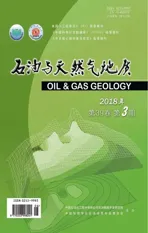异重流发育条件、演化过程及沉积特征
2018-06-22栾国强董春梅林承焰任丽华焦红岩赵海燕彭先国中国石油大学华东地球科学与技术学院山东青岛266580山东省油藏重点实验室山东青岛266580中国石化胜利油田有限公司现河采油厂山东东营257068
栾国强,董春梅,2,林承焰,2,任丽华,2,焦红岩,赵海燕,彭先国[.中国石油大学(华东) 地球科学与技术学院,山东 青岛 266580; 2.山东省油藏重点实验室,山东 青岛 266580;.中国石化 胜利油田有限公司 现河采油厂,山东 东营 257068]
1 异重流研究历史
广义的异重流指两种密度相差不大、可以相混的流体,在条件适宜时因密度差异而产生的相对运动。在运动过程中不发生全局性紊动、掺混。异重流分为双层体系和多层体系,自然界中异重流现象非常广泛,既包括水体中的分层潜流,也包括大气中的冷暖空气所形成的锋面。但在水利工程和地质学领域,异重流是指河流携带大量沉积物直接潜入蓄水盆地底部并继续流动的高密度流体[1-3]。
1885年Forel首次报道了罗恩河注入日内瓦湖时发生的异重流现象[4],20世纪30年代以后,异重流研究才真正受到重视。1935年美国科罗拉多河胡佛坝落成蓄水,当年3月份,上游发生洪水,河流携大量泥沙在胡佛大坝前沉入水底,不久后浑浊的泥水从大坝泄水孔流出,在此过程中水库表面始终澄清[5]。这一现象让人们意识到异重流可以携带大量泥沙沿水库底部长距离搬运而不与蓄水体相混,这对于降低水库淤积,延长水库寿命具有重要意义。1953年Bates首次提出异重流的概念,但在地质领域,对于海洋环境中是否存在异重流及其对海相深水沉积的影响却仍然存在巨大争议。直到20世纪90年代,相关研究表明河流入海形成异重流的现象具有普遍性[2,6],异重流作为一种深水沉积物输送机制逐渐受到地质学家的重视[7-42](表1;图1)。
2 异重流形成条件与影响因素
2.1 形成条件
河流与蓄水体的密度差异是异重流发生的直接原因[2,6,24,43-48]。河流所携沉积物量、水体盐度及温度等都是影响河水密度的重要因素[49]。河流入海形成异重流的沉积物临界浓度为36~44 kg/m3,临界浓度与海水温度和含盐度密切相关,受气候背景和所处纬度控制[2](表2)。洪峰到达前河流对蓄水体的稀释作用[50]会降低河口处蓄水体密度,有利于异重流的发生。严格来讲,异重流形成的临界浓度是蓄水体密度(河口周围)、流量、水深和坡降的函数,河口处坡度大、水体深,形成异重流的沉积物临界浓度也会相应降低。在陆相淡水湖盆中,异重流形成的沉积物临界浓度非常低(远低于1 kg/m3)[2,51]。如果河水与湖水温度和盐度相差不大,河水所携带沉积物浓度只要略大于千分之一,入湖后便可以形成异重流[52]。通常来说,洪泛期的中小型山区河流更易形成异重流,而大型河流由于流速低,流量大,入海过程中沉积物易发生稀释和卸载,难以形成异重流[6]。Mulder等调研了全球147条河流的异重流发育情况,发现71%的河流会发育不同频次的异重流[2],而实际上异重流的发生可能更加普遍。
不稳定的异轻流可以向异重流转化,这是一种特殊而普遍的异重流形成机制[25,32,53]。温暖的富含细粒沉积物的河水在河口形成异轻流,在沉积物自身扩散和水体扰动(波浪、潮汐等作用)影响下,异轻流与蓄水体界面之间的平衡被破坏,发生指对流现象(finger convection),富沉积物流体通过指对流到达盆地底部,形成异重流[53](图2)。通过指对流机制产生的异重流,其主要沉积物为富含陆源有机质的粘土[25]。如果异轻流长时间保持稳定,所含细粒沉积物会发生絮凝作用,以海洋雪的方式沉降[54]。
2.2 主要影响因素
异重流的形成受构造和气候影响,与源汇系统密切相关。
2.2.1 源区特征
一定的沉积物浓度是异重流形成的重要条件[48,55],如果源区能够提供大量的碎屑物质,则有利于异重流的形成。源区构造演化与地形起伏是碎屑沉积物形成的基础,母岩固结程度低,构造高差大,易发生侵蚀搬运作用。气候是沉积物形成的重要条件,一般认为半干旱气候下,物源区植被稀少,容易发生水土流失[56],同时伴随周期性洪水的发生,有利于河流携带大量悬浮物质形成异重流[48,57-58]。
2.2.2 河流流域
河流是源汇系统内沉积物输送的重要通道[59],河流流域特征决定了河流类型、流量及沉积物输送能力[6,60]。河流从物源区携带的沉积物只有少部分能直接到达沉积盆地,其余大部分会在搬运路途中发生暂时性沉积,形成心滩、边滩、决口扇、山麓冲积扇及冲积平原等[61],大量暂时性沉积的发生会缓冲河流向盆地搬运沉积物的效率。一般来说,流域面积越大,地形高差越低,河流输送能力越差[6,62-65]。流域气候条件也会对河流输送能力产生重要影响,蒸发量大,导致河流流量降低,沉积物在河流区域大量携载,不利于异重流发生。因此,相对于大型河流,中小型的山间河流因为流域面积小,高程大,蒸发量低,易于形成异重流[6]。
2.2.3 汇水盆地
蓄水体盐度、水深、温度以及河口坡降等都是影响河流潜入的重要因素,盆地水体盐度低、温暖、有一定水深和较大的河口坡降,会降低异重流形成的沉积物临界浓度。异重流发生还与海/湖平面高低有密切关系[26,48,66-73],在狭窄大陆架条件下,低水位体系域时,河流可直接进入大陆坡峡谷,有利于异重流的形成;而在宽阔大陆架地带,低水位体系域时,河流流域面积增大,中小型河流发生合并,形成大河,更利于三角洲和滑塌型重力流的发生。
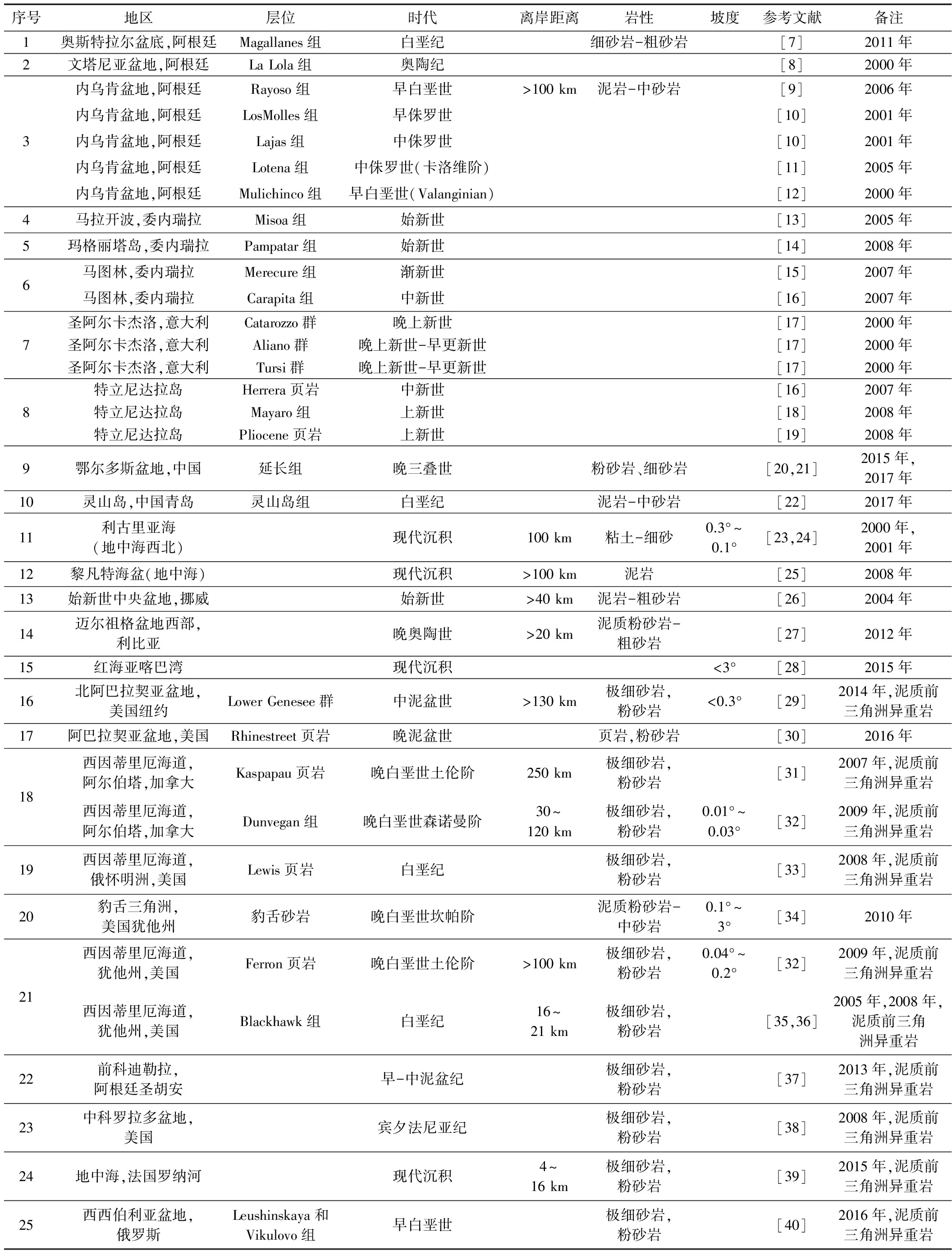
表1 异重流沉积研究实例Table 1 Case study of hyperpycnal flow deposition

图1 异重流沉积研究实例全球分布示意图Fig.1 Global distribution of case study of hyperpycnal flow deposition

表2 不同气候环境下海水温度、盐度、密度及对应的河流沉积物临界浓度(引自文献[2])Table 2 Temperature,salinity and density of seawater in different climates,and the correspondingcritical concentration of river sediments(cited from reference [2])
3 异重流演化过程及沉积特征
3.1 演化过程
在洪水到达之前,由于河水中所携带沉积物浓度低,河水密度低于蓄水体密度,在河口处粗碎屑物质卸载,形成三角洲河口沙坝,河水缓慢向前漂浮在蓄水体表面,形成异轻流(图3a)。随着洪水发育,河流携带沉积物浓度越来越大,当河水浓度与蓄水体浓度相等时,河水与海水整体混合,形成等密度流(图3b)。在洪水作用下,河流流速加快,所携带沉积物浓度增加,河水密度大于蓄水体密度,达到潜入临界条件,河流直接潜入水底,形成向盆地深处运移的异重流(图3c)。异重流的发生会带动周围水体的运动,形成局部水循环,倒吸先前漂浮在水面的异轻流,大量水体表面漂浮物在潜入点处聚集,形成分明的清浑交界面(图4a)。

图2 尼罗河河口异轻流-异重流转化作用(据文献[25]修改)Fig.2 Conversion from hypopycnal flow to hyperpycnal flow at the estuary of Nile River(modified from reference [25])
在海洋和盐湖环境中,如果异重流头部速度过低,其所携带沉积物的浓度小,局部密度低于周围水体密度,会发生浮力反转,形成上浮相(图3,图4),上浮相开始产生的位置为上浮点,上浮点位置随异重流头部运动发生迁移,在异重流增强期,上浮点随异重流向盆运动,在异重流衰退期,上浮点随异重流向岸运动(图3c—f)。上浮点的运移方式有连续运移和幕式运移,这取决于异重流能量演化特征。上浮相与异重流所携带的沉积物类型和流速有密切关系,以粘土为主的异重流不易产生上浮相[74]。异重流衰退末期完全上浮,回归等密度流和异轻流(图3g,h)。
3.2 主要岩相类型
异重流存在3种沉积物搬运方式——底床载荷、悬浮载荷和上浮载荷(图5)。其中底床载荷沉积物主要以滚动和跳跃方式搬运;悬浮载荷是异重流主要沉积物运载方式,沉积物以悬浮状态发生搬运;上浮载荷是指异重流末端沉积物大量卸载,异重流密度低于环境水体密度后,沉积物发生上浮扩散的一种搬运方式,主要发生在海相和盐湖环境中。
异重流沉积的岩相类型与沉积物负载方式密切相关[75-77],底床载荷主要沉积细砾岩与砾质砂岩,常见的沉积构造有块状层理、叠瓦状构造、低角度交错层理、平行层理等。悬浮载荷主要沉积细砂岩、粉砂岩,典型的沉积构造有平行层理、爬升沙纹层理、波状层理等。沉积物重新聚集和上浮部分主要沉积水平层理泥岩和粉砂质泥岩,层面富含有机质和异地搬运的植物碎屑[78](图5)。异重流由近源到远源过程中,能量亏损,流速降低,底床载荷、悬浮载荷和上浮载荷依次卸载形成特有的沉积序列。
3.3 沉积序列
单期异重岩沉积过程与异重流能量演化过程密切相关,因此异重岩垂向沉积序列记录了异重流能量增强和减弱两个演化阶段[24](图3,图6,图7)。在洪水发育初期,异重流能量不断增强,沉积物具有反序特征,并依次发育爬升波纹层理、平行层理和低角度交错层理等沉积构造;洪峰过后,随着洪水能量衰减,异重流所携带沉积物由粗到细依次卸载,沉积物具有正序特征,沉积构造与异重流能量增强阶段相反。这种反映洪水能量增强的反序沉积单元(Ha)和反映洪水能量减弱的正序沉积单元(Hb)所组成的二元结构是异重岩典型沉积序列(图6)[9,24,33,74,79-80]。异重流除了经历增强和减弱两个大的变化阶段外,同一位置异重流能量会有多次波动(图6),这一特点体现为异重流流动过程的脉动性。
洪峰活动期间,如果异重流能量未达到对下伏沉积物造成侵蚀的临界条件,Ha与Hb之间连续接触,沉积物最大粒度代表的接触界面响应于洪峰(图6Ⅲ,图7Ⅲ);如果洪峰期间异重流能量超过对下伏沉积物造成侵蚀的临界条件,异重流能量增强阶段形成的沉积物会被部分侵蚀,洪峰过后随异重流能量减弱,沉积物继续在侵蚀面之上沉积,Ha与Hb侵蚀接触(图6Ⅱ,图7Ⅱ);当洪峰能量足够大,持续时间足够长,异重流能量增强阶段形成的反序单元(Ha)在洪峰期会被完全侵蚀,洪峰过后随异重流能量降低,沉积物卸载,仅保存正序单元(Hb)(图6Ⅰ,图7Ⅰ)。实际上由于河流注入量和所携带沉积物浓度的变化,异重流存在多个能量波动过程[41],导致单期异重岩沉积序列更加复杂。异重流不仅有时间上的波动性,还有空间上的迟滞性。离河口越远,异重流速度越低,一期洪峰总是先到达近端,一段时间之后才能传播到远端(图6),导致同一能量波动在不同位置异重岩中的时间响应不同,同一期异重流在不同位置形成的沉积序列不同(图7)。

图3 异重流演化过程[74] Fig.3 Evolution of hyperpycnal flow[74] a.洪水初期,异轻流发育;b.随洪水能量增强,河流携带沉积物浓度达到临界浓度,等密度流形成;c.随洪水能量增强,异重流形成并加速向深水流动;d.洪峰到达,异重流能量达到最强;e.洪峰之后,异重流能量开始衰减;f.异重流能量进一步衰减;g.异重流衰减为等密度流;h.洪水过后,等密度流恢复为异轻流

图4 红海阿卡巴湾异重流[28]Fig.4 Hyperpycnal flows in the Gulf of Aqaba,Red Sea[28]a.异重潜入点处清浑交界;b,c.异重流表面上浮相
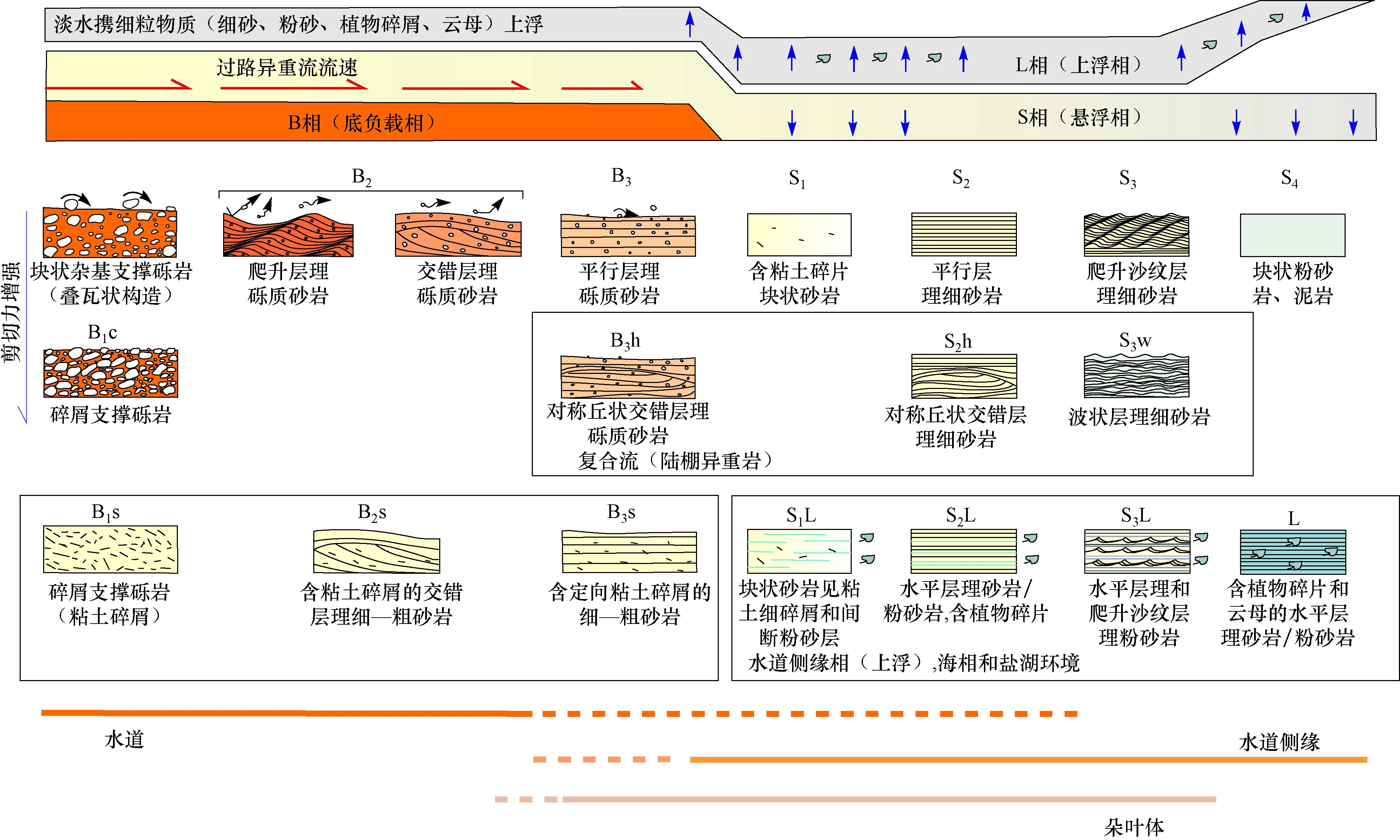
图5 异重岩主要岩相类型[74]Fig.5 Major lithofacies of hyperpycnites[74]
异重流近端洪峰期能量强,对下伏沉积物侵蚀强烈,以正序水道充填沉积为主;中部洪峰期异重流能量中等,形成侵蚀接触的Ha-Hb二元结构,侵蚀面附近富含泥砾。远端洪峰期异重流能量低,形成连续接触的Ha-Hb二元结构(图6,图7)。

图6 异重流沉积演化过程(据文献[9]修改)Fig.6 Depositional evolution of hyperpycnal flows (modified from reference [9])

图7 异重流沉积序列(图中Ⅰ,Ⅱ,Ⅲ位置与图6中Ⅰ,Ⅱ,Ⅲ位置相对应)Fig.7 Sedimentary sequence of hyperpycnal flows (location Ⅰ,Ⅱand Ⅲ are also the location Ⅰ,Ⅱand Ⅲ in Fig.6)
3.4 沉积模式
河流携带沉积物直接入水所形成的异重流沉积与盆内滑塌型浊流存在差异。本文在总结阿根廷内乌肯盆地、美国阿巴拉契亚盆地、中国的松辽盆地和鄂尔多斯盆地等古代异重流沉积的基础上,结合地中海现代深水水道发育特征,建立了由沟道充填沉积-天然堤-沟道侧缘沉积-前缘朵叶体组成的异重流沉积的理想模式(图8)。异重流沉积近端,由于能量较强,侵蚀作用显著,沟道陡深,由近端向远端逐渐变宽缓,沟道底部充填底负载相的细砾岩和砾质砂岩,向上依次为悬浮相细砂岩、粉砂岩和上浮相泥岩,具有显著的正序特征。两侧天然堤主要由悬浮相的细砂岩、粉砂岩和上浮相泥质粉砂岩、泥岩组成,由沟道向两侧粒度减小,泥质含量增加,逐渐过渡到沟道侧缘沉积。沟道侧缘沉积主要由上浮相的泥质粉砂岩、粉砂质泥岩和泥岩组成,常见大量植物碎屑和红色层理。在异重流沉积前缘末端,由于没有沟道约束,沉积物大量溢出,形成以悬浮相和上浮相为主的前缘朵叶体,该部分沉积物与天然堤和侧缘沉积相似,具有典型的Ha-Hb二元结构。
4 讨论
4.1 异重流与经典浊流的区别
沉积物重力流包括盆内滑塌型重力流和盆外洪水型异重流[81-82],两类重力流在成因机制、流体动力学过程及沉积特征等方面都存在差异性,进一步造成油气储层分布的不同[21,82]。同时,由于传统的涌浪型浊流与异重流存在相似性,致使在以往研究中有大量异重流沉积被解释为经典浊流沉积[9]。因此认识传统浊流沉积与异重流沉积的区别与联系,对于建立和完善深水重力流沉积模式具有重要意义。

图8 异重流沉积模式Fig.8 Depositional model of hyperpycnal flows
根据Ha-Hb二元结构、内部侵蚀突变界面、富含陆源植物碎屑等特征可以从岩心和露头对异重流和经典浊流沉积进行初步识别,但更多的识别标志仍需要进一步发掘,两种不同沉积的地球物理差异性仍然有待研究(表3)。
在实际研究中,三角洲地带往往存在三角洲-异重流-盆内重力流综合沉积作用(图9)[83]。洪水期间异重流的发生可以作为触发机制,造成斜坡失稳,产生盆内重力流,导致多种重力流事件同时发生[20,84];进积型三角洲带来的沉积物大量堆积,也可以为盆内重力流提供物质基础,导致盆外和盆内重力流交替发生。盆内和盆外重力流的混合发育以及复杂的流体转化过程,增加了重力流研究的挑战性。
4.2 异重流与细粒沉积
异重流对深水细粒沉积有重要影响。细粒沉积物形成于弱水动力条件一直是沉积学界的共识,然而近年来沉积学家们通过大量的实际观察和实验研究逐渐认识到,在较强水动力条件下也可以沉积细粒物质[85-89]。异重流是细粒沉积物重要的运载方式之一[48,74,81,90],异重流中的悬浮相和上浮相都以细粒沉积物为主,泥质异重流和通过指对流方式形成的异重流所携沉积物以粘土为主,异重流可以携带大量陆源细粒沉积物直接进入深水形成细粒沉积,对正常深水环境产生重要影响。
洪水期间,泥质异重流从三角洲前缘溢出,可在平缓的地形条件下将大量陆源细粒沉积物输送上百千米,在近海大陆架形成大规模泥质沉积。这种成因的细粒沉积岩在浅海陆架地区具有普遍性,被称为泥质前三角洲异重岩[29]。泥质前三角洲异重岩通常由粉砂岩和泥岩组成,单层厚度为厘米尺度,下部发育侵蚀面。单层内部主要由3部分组成,下部为发育脉动式牵引流特征的泥质粉砂岩或粉砂质泥岩,中间为无明显宏观特征的泥岩,最上部为发育大量生物变形构造的泥岩[29](图10)。单层的沉积过程大致可分为3个阶段,首先是过路侵蚀阶段,形成下部的侵蚀界面,之后在异重流能量亏损阶段,开始沉积形成下部的泥质粉砂岩、粉砂质泥岩(推移质)和中间的泥岩(悬浮质),最后形成上部的暗色泥岩并发育生物扰动(图10)。

表3 异重流与经典浊流沉积差异对比Table 3 Similarities and differences between typical turbidites and hyperpycnal flows
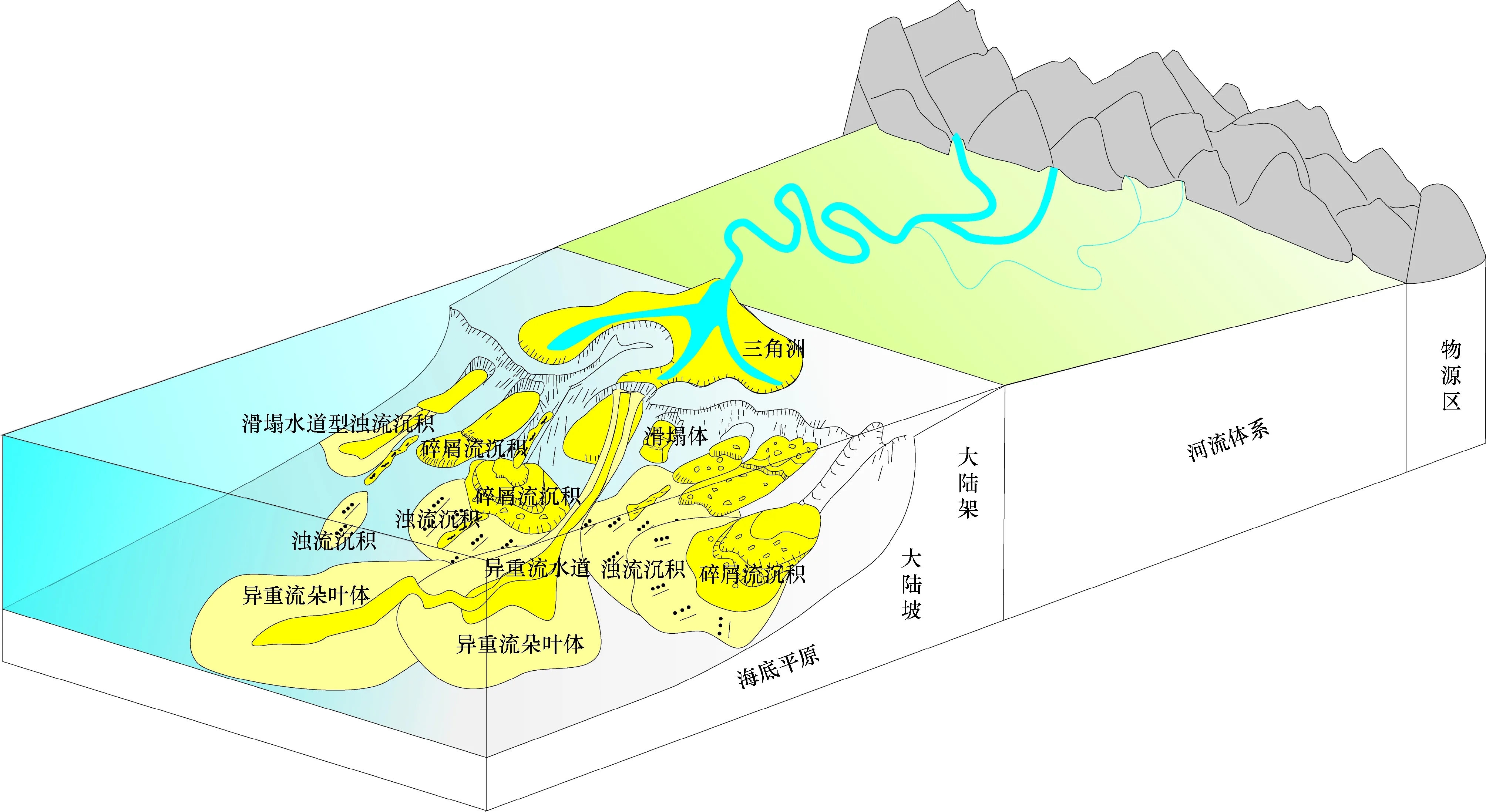
图9 三角洲-异重流-滑塌重力流综合沉积模式Fig.9 Composite depositional model of delta,hyperpycnal flow,and slumping gravity flow
由于异重流能量的波动性,泥质前三角洲异重岩在单层系和层系组级别发育正粒序和反粒序,但在几十到上百米的准层序级别具有向上变粗变厚的反序特征[32]。
异轻流、层间流、滑塌型重力流都是深水细粒沉积物的重要供给方式,但异重流特殊性在于将河水和陆源沉积物直接输送到盆地底部,大量陆源物质的加入,会改变深层水体含氧量、含盐度等物理化学性质,从而对原地有机质的保存产生影响,同时形成大量陆源有机质沉积[32,79,91]。
4.3 中国陆相湖盆异重流沉积研究
相比于海相环境,陆相湖盆由于水体盐度低、物源近、以中小型河流为主等特点,更容易发生异重流。杨仁超等(2017)从构造和气候角度,对鄂尔多斯盆地异重流沉积特征开展研究,并提出了异重岩测井识别标志[21]。冯志强等(2010)发现松辽盆地嫩江组发育大规模湖底水道系统,起源于杏树岗三角洲,在平缓的湖底延伸70 km,最后成扇体撒开(图11),岩心中发育植物叶片、平行层理和交错层理[92],综合分析这些特征,可初步判断为异重流沉积。我国陆相湖盆普遍发育的洪水型湖底扇,其形成机制及沉积特征都与底负载型异重流类似。渤海湾盆地济阳坳陷东营三角洲在沙三中亚段发生大规模进积,同时形成了一系列滑塌浊积体,是岩性油气藏勘探重点区块[93-94],但岩心观察发现,该地区存在大规模异重流沉积过程(图12),有效区分滑塌浊积和异重流沉积,对于进一步推动该地区的勘探工作有重要意义。

图10 纽约中部中泥盆世杰纳西奥组细粒沉积岩异重流沉积模式及理想岩相特征[29] Fig.10 Depositional model and idealized lithofacies features of hyperpycnal flows with fine-grained sedimentary rocks in the Middle Denovian Genesee Formation,central New York[29]a. Northern Appalachian盆地泥盆世素描图,发生异重流沉积;b.图a中沿A—B剖面图,异重流发育底负载、悬浮负载和上浮负载;c.理想泥质异重流岩相序列素描图

图11 松辽盆地嫩江组陆相湖盆湖底水道体系(据文献[92]修改)Fig.11 Bottom channel system of a continental lacustrine basin in the Neijiang Formation,Songliao Basin(modified from reference [92])
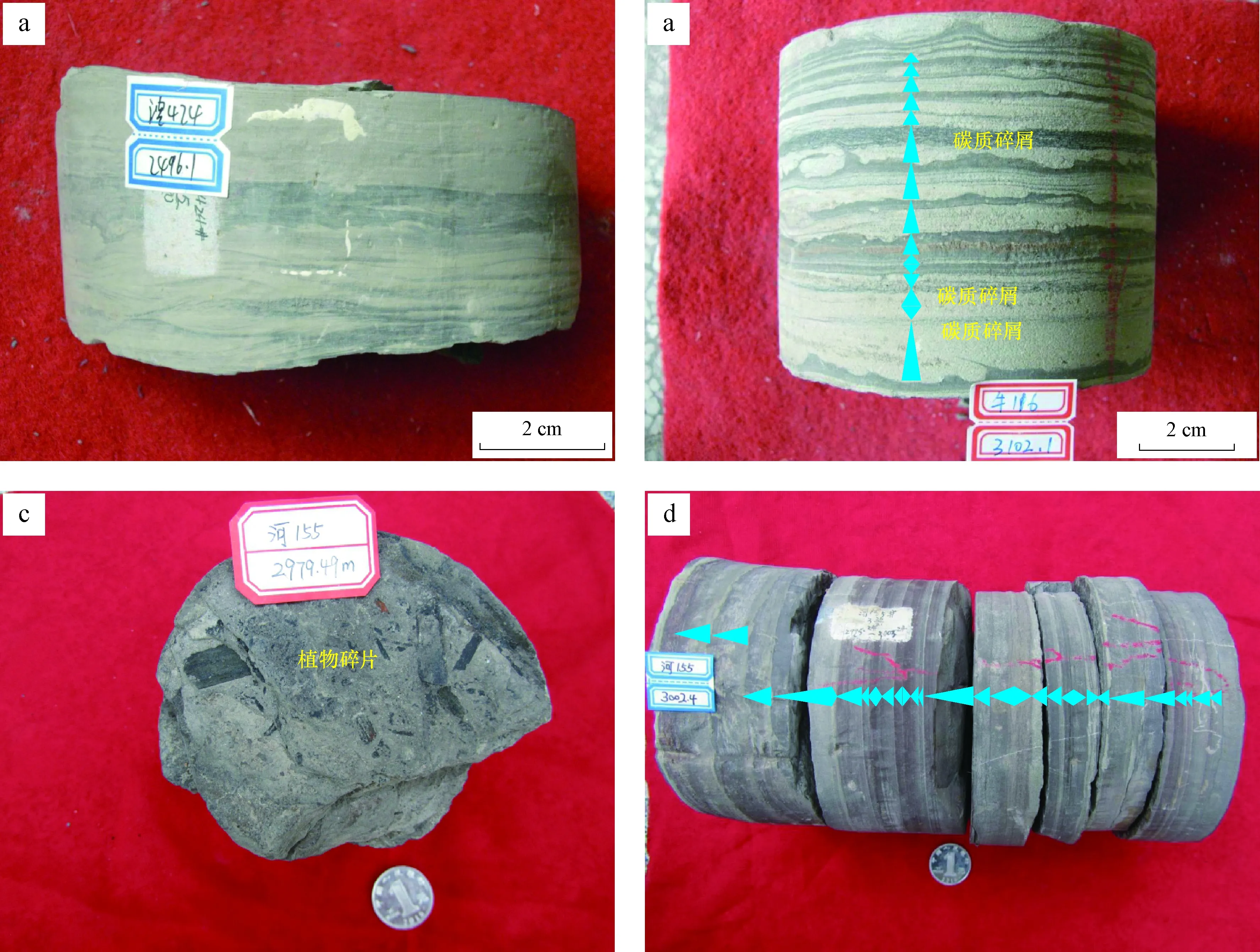
图12 东营凹陷沙三中亚段异重流沉积构造Fig.12 Sedimentary structure of hyperpycnal flows in the middle Es3,Dongying saga.上攀层理,滨424井,埋深2 496.1 m;b.逆正粒序,局部炭质碎屑成层富集,发育火焰状构造,说明上部沉积时下部泥质富含水,为同一期异重流能量波动成因,牛116井,埋深3 102.1 m;c.层面富集植物碎片,河155井,埋深2 979.49 m;d.逆正粒序泥质粉 砂岩,发育红色层理,河155井,埋深3 002.4 m
5 结论
1) 异重流作为一种深水沉积物输送机制,其发育具有普遍性。对异重流的成因机制、演化过程及沉积特征开展研究有助于加深对深水重力流沉积的理解。有效区分异重流与盆内滑塌型浊流,建立异重流沉积岩心-测井-地震识别标志,完善异重流沉积模式,是异重流研究的当务之急。
2) 异重流能够沿相对平缓地形将陆源沉积物输送上百公里,泥质异重流对于盆地细粒沉积具有重要影响,异重流研究对于进一步拓展隐蔽油气藏勘探范围,指导非常规油气勘探具有重要意义。
3) 中国陆相湖盆异重流沉积研究处于起步阶段,将异重流沉积体系与现有陆相湖盆沉积体系融合,建立陆相湖盆异重流沉积模式,必将进一步推动中国湖相油气勘探进程。
参 考 文 献
[1] Bates C C.Rational theory of delta formation[J].AAPG Bulletin,1953,37(9):2119-2162.
[2] Mulder T,Syvitski J P M.Turbidity currents generated at river mouths during exceptional discharges to the world oceans[J].The Journal of Geology,1995,103(3):285-299.
[3] Mulder T,Syvitski J P M.Climatic and morphologic relationships of rivers:implications of sea-level fluctuations on river loads[J].The Journal of Geology,1996,104(5):509-523.
[4] Forel F A.Les ravins sous-lacustres des fleuves glaciaires[M].Paris:Gauthier-Villars,1885.
[5] Grover N C,Howard C L.The passage of turbid water through lake mead[J].Transactions of the American Society of Civil Engineers,1938,103(1):720-781.
[6] Milliman J D,Syvitski J P M.Geomorphic/tectonic control of sediment discharge to the ocean:the importance of small mountainous rivers[J].The Journal of Geology,1992,100(5):525-544.
[7] Buatois L A,Saccavino L L,Zavala C.Ichnologic signatures of hyperpycnal flow deposits in Cretaceous river-dominated deltas,Austral Basin,southern Argentina[M]∥Slatt R M,Zavala C.Sediment transfer from shelf to deep water-Revisiting the delivery system.Tulsa:AAPG,2011:153-170.
[8] Zavala C,Azúa G,Freije R H,et al.Grupo Curamalal(Paleozoico inferior),Cuenca paleozoica de Ventania,provincia de Buenos Aires,Argentina[J].Revista de la Asociación Geológica Argentina,2000,55(3):165-178.
[9] Zavala C.Ancient lacustrine hyperpycnites:A depositional model from a case study in the Rayoso Formation(Cretaceous)of West-Central Argentina[J].Journal of Sedimentary Research,2006,76(1-2):41-59.
[10] Zavala C,González R.Estratigrafia del Grupo Cuyo(Jurásico inferior-medio)en la Sierra de la Vaca Muerta,cuenca Neuquina[J].Boletín de Informaciones Petroleras,2001,65:40-54.
[11] Zavala C.Tracking sea bed topography in the Jurassic:the Lotena Group in the Sierra de la Vaca Muerta(Neuquén Basin,Argentina)[J].Geologica Acta,2005,3(2):107-118.
[12] Zavala C.Nuevos avances en la sedimentología y estratigrafía secuencial de la Formación Mulichinco en la Cuenca Neuquina[J].Boletín de Informaciones Petroleras,2000,63:40-54.
[13] Gamero H,Zavala C,Contreras C.A reinterpretation of the Misoa facies types:Implications of a new depositional model,Maracaibo Basin,Venezuela[C]∥2005 AAPG International Conference and Exhibition:Evolving stratigraphic techniques and interpretation III.Paris:AAPG,2005.
[14] Guzmán O,Campos C.The Pampatar Formation(Margarita Island,Venezuela):A result of gravity flows in deep marine water[C]∥AAPG Hedberg Conference:Sediment transfer from shelf to deepwater-Revisiting the delivery mechanisms.Argentina:AAPG,2008.
[15] Zavala C,Marcano J,Carvajal J.Proximity and laterality indexes:a new tool for the analysis of ancient hyperpycnal deposits in the subsurface[C]∥GSTT 4th Geological Conference.Trinidad and Tobago:GSTT,2007.
[16] Gamero H,Reader J,Izatt C,et al.Herrera sandstones in the Southern Basin Area,Trinidad:Evidence of hyperpycnites deposited away from ancient Oficina delta systems in eastern Venezuela[C]∥2007 AAPG Annual Meeting Abstracts volume.California:AAPG,2007:51.
[17] Zavala C.Stratigraphy and sedimentary history of the Plio-Pleistocene Sant’Arcangelo basin,Southern Apennines,Italy[J].Rivista Italiana Di Paleontologia E Stratigrafia,2000,106(3):399-416.
[18] Zavala C,Valiente L B,Vallez Y.The origin of lofting rhythmites.Lessons from thin sections[C]∥AAPG Hedberg Conference:Sediment transfer from shelf to deepwater-Revisiting the delivery mechanisms.Argentina:AAPG,2008.
[19] Gamero H,Lewis N,Welsh R,et al.Evidences of a shelfal hyperpycnal deposition in the Pliocene sandstones in the Oilbird field,SE Coast,Trinidad:Impact on reservoir distribution and field redevelopment[C]∥AAPG Hedberg Conference:Sediment transfer from shelf to deepwater-Revisiting the delivery mechanisms.Argentina:AAPG,2008.
[20] 杨仁超,金之钧,孙冬胜,等.鄂尔多斯晚三叠世湖盆异重流沉积新发现[J].沉积学报,2015,33(1):10-20.
Yang Renchao,Jin Zhijun,Sun Dongsheng,et al.Discovery of hyperpycnal flow deposits in the Late Triassic Lacustrine Ordos Basin[J].Acta Sedimentologica Sinica,2015,33(1):10-20.
[21] Yang R,Jin Z,Van Loon A J,et al.Climatic and tectonic controls of lacustrine hyperpycnite origination in the Late Triassic Ordos Basin,central China:Implications for unconventional petroleum development[J].AAPG Bulletin,2017,101(1):95-117.
[22] Yang T,Cao Y,Wang Y.A new discovery of the early cretaceous supercritical hyperpycnal flow deposits on Lingshan Island,East China[J].Acta Geologica Sinica(English Edition),2017,91(2):749-750.
[23] Migeon S,Savoye B,Faugeres J C.Quaternary development of migrating sediment waves in the Var deep-sea fan:distribution,growth pattern,and implication for levee evolution[J].Sedimentary Geology,2000,133(3-4):265-293.
[24] Mulder T,Migeon S,Savoye B,et al.Inversely graded turbidite sequences in the deep Mediterranean:a record of deposits from flood-generated turbidity currents?[J].Geo-Marine Letters,2001,21(2):86-93.
[25] Ducassou E,Mulder T,Migeon S.Nile floods recorded in deep Mediterranean sediments[J].Quaternary Research,2008,70(3):382-391.
[26] Plink-Björklund P,Steel R J.Initiation of turbidity currents:outcrop evidence for Eocene hyperpycnal flow turbidites[J].Sedimentary Geology,2004,165(1):29-52.
[27] Girard F,Ghienne J F,Rubino J L.Occurrence of hyperpycnal flows and hybrid event beds related to glacial outburst events in a Late Ordovician Proglacial Delta(Murzuq Basin,SW Libya)[J].Journal of Sedimentary Research,2012,82(9):688-708.
[28] Katz T,Ginat H,Eyal G,et al.Desert flash floods form hyperpycnal flows in the coral-rich Gulf of Aqaba,Red Sea[J].Earth & Planetary Science Letters,2015,417:87-98.
[29] Wilson R D,Schieber J.Muddy prodeltaic hyperpycnites in the Lower Genesee Group of Central New York,USA:Implications for mud transport in Epicontinental Seas[J].Journal of Sedimentary Research,2014,84(10):866-874.
[30] Lash G G.Hyperpycnal transport of carbonaceous sediment-Example from the Upper Devonian Rhinestreet Shale,western New York,U S A [J].Palaeogeography Palaeoclimatology Palaeoecology,2016,459:29-43.
[31] Varban B L,Guy Plint A.Sequence stacking patterns in the Western Canada foredeep:Influence of tectonics,sediment loading and eustasy on deposition of the Upper Cretaceous Kaskapau and Cardium formations[J].Sedimentology,2008,55(2):395-421.
[32] Bhattacharya J P,Maceachern J A.Hyperpycnal rivers and prodeltaic shelves in the Cretaceous Seaway of North America[J].Journal of Sedimentary Research,2009,79(4):184-209.
[33] Soyinka O A,Slatt R M.Identification and micro-stratigraphy of hyperpycnites and turbidites in Cretaceous Lewis Shale,Wyoming[J].Sedimentology,2008,55(5):1117-1133.
[34] Olariu C,Steel R J,Petter A L.Delta-front hyperpycnal bed geometry and implications for reservoir modeling:Cretaceous Panther Tongue delta,Book Cliffs,Utah[J].AAPG Bulletin,2010,94(6):819-845.
[35] Pattison S A J.Isolated highstand shelf sandstone body of turbiditic origin,lower Kenilworth Member,Cretaceous Western Interior,Book Cliffs,Utah,USA[J].Sedimentary Geology,2005,177(1-2):131-144.
[36] Pattison S A J,Williams H,Davies P.Clastic sedimentology,sedimentary architecture,and sequence stratigraphy of fluvio-deltaic,shoreface,and shelf deposits,Upper Cretaceous,Book Cliffs,eastern Utah and western Colorado[M]∥Raynolds R G.Roaming the Rocky Mountains and Environs:Geological Field Trips.Denver:The Geolo-gical Society of America,2008(10):17-43.
[37] de Luca P H V,Basilici G.A prodeltaic system controlled by hyperpycnal flows and storm waves:reinterpretation of the Punta Negra Formation(Lower-Middle Devonian,Argentine Precordillera)[J].Brazilian Journal of Geology,2013,43(4):673-94.
[38] Lamb M P,Myrow P M,Lukens C,et al.Deposits from wave-infl-uenced turbidity currents:Pennsylvanian Minturn Formation,Colorado,U S A [J].Journal of Sedimentary Research,2008,78(7-8):480-98.
[39] Mulder T,Joumes M,Bassetti M A,et al.Flood characterization in Rhǒne prodelta sediments[C]∥EGU General Assembly Conference Abstracts.Vienna:EGU,2015:17.
[40] Zavala C,Arcuri M,Di Meglio M,et al.Prodelta hyperpycnites:Facies,processes and reservoir significance.Examples from the lower cretaceous of Russia[C]∥International Conference and Exhibition,Barcelona,Spain,2016.Spain :Society of Exploration Geophysicists and American Association of Petroleum Geologists,2016:73-73.
[41] Lamb M P,Mohrig D.Do hyperpycnal-flow deposits record river-flood dynamics?[J].Geology,2009,37(12):1067-1070.
[42] 李涛,谈广鸣,张俊华,等.水库异重流研究进展[J].中国农村水利水电,2006,9:21-24.
Li Tao,Tan Guangming,Zhang Junhua,et al.Progress in the study of reservoir hyperpycnal flow[J].China Rural Water and Hydropower,2006,9:21-24.
[43] 范家骅.异重流泥沙淤积的分析[J].中国科学,1980,(1):82-89.
Fan Jiahua.Anylysis of hyperpycnal flow sediments diposition[J].Science China Press,1980,(1):82-89.
[44] 范家骅.沉淀池异重流的实验研究[J].中国科学A辑,1984,(11):1053-1064.
Fan Jiahua.Experiment study of hyperpycnal flow in sedimentation tank[J].Science China PressA,1984,(11):1053-1064.
[45] 范家骅,王华丰,黄寅,等.异重流的研究和应用[M].北京:水利电力出版社,1959.
Fan Jiahua,Wang Huafeng,Huang Yin,et al.The research and application of hyperpycnal flow[M].Beijing:Water Resources and Electric Power Press,1959.
[46] 曹文洪,姜乃森,傅玲燕,等.白石水库泥沙问题的试验研究[J].水利水电技术,1997,(9):20-23.
Cao Wenhong,Jiang Naisen,Fu Lingyan,et al.Model study on sedimentation problems in the Baishi Reservoir[J].Water Resources and Hydropower Engineering,1997,(9):20-23.
[47] Mulder T,Migeon S,Savoye B,et al.Twentieth century floods recorded in the deep Mediterranean sediments[J].Geology,2001,29(11):1011-1014.
[48] Mulder T,Syvitski J P M,Migeon S,et al.Marine hyperpycnal flows:initiation,behavior and related deposits.A review[J].Marine & Petroleum Geology,2003,20(6-8):861-882.
[49] 解河海,张金良,郝振纯,等.水库异重流研究综述[J].人民黄河,2008,30(5):28-30.
Xie Hehai,Zhang Jinliang,Hao Zhenchun,et al.Review on the research of reservoir hyperpycnal flow[J].Yellow River,2008,30(5):28-30.
[50] Mulder T,Syvitski J P M,Skene K I.Modeling of erosion and deposition by turbidity currents generated at river mouths[J].Journal of Sedimentary Research,1998,68(1):124-137.
[51] Johnson K S,Paull C K,Barry J P,et al.A decadal record of underflows from a coastal river into the deep sea[J].Geology,2001,29(11):1019-1022.
[52] Bell H S.The effect of entrance mixing on the size of density currents in Shaver Lake[J].Eos Transactions American Geophysical Union,1947,28(5):780-791.
[53] Parsons J D,Bush J W M,Syvitski J P M.Hyperpycnal plume formation from riverine outflows with small sediment concentrations[J].Sedimentology,2001,48(2):465-478.
[54] Macquaker J H S.Mudstone sedimentation at high latitudes:Ice as a transport medium for mud and supplier of nutrients[J].Journal of Sedimentary Research,2005,75(4):696-709.
[55] Alexander J,Mulder T.Experimental quasi-steady density currents[J].Marine Geology,2002,186(3-4):195-210.
[56] Summerfield M A.Global geomorphology[M].Longdon and New York:Routledge,2014.
[57] Petter A L,Steel R J.Hyperpycnal flow variability and slope organization on an Eocene Shelf Margin,Central Basin,Spitsbergen[J].AAPG Bulletin,2006,90(10):1451-1472.
[58] Wright L D,Yang Z S,Bornhold B D,et al.Hyperpycnal plumes and plume fronts over the Huanghe(Yellow River)delta front[J].Geo-Marine Letters,1986,6(2):97-105.
[59] Allen P A.From landscapes into geological history[J].Nature,2008,451(7176):274.
[60] Milliman J D,Meade R H.World-wide delivery of river sediment to the oceans[J].The Journal of Geology,1983,91(1):1-21.
[61] Allen P A,Allen J R.Basin analysis:Principles and application to petroleum play assessment[M].Oxford:Wiley-Black well,2013.
[62] Wilson L.Variations in mean annual sediment yield as a function of mean annual precipitation[J].American Journal of Science,1973,273(4):335-349.
[63] Meade R H.Sources,sinks,and storage of river sediment in the Atlantic Drainage of the United States[J].The Journal of Geology,1982,90(3):235-252.
[64] Pinet P,Souriau M.Continental erosion and large-scale relief[J].Tectonics,1988,7(3):563-582.
[65] Dickinson W R.Provenance and sediment dispersal in relation to paleotectonics and paleogeography of sedimentary basins[M]∥Kleinspehn K L,Paola C.New perspectives in basin analysis.New York:Springer,1988:3-25.
[66] Mutti E.Turbidite systems and their relations to depositional sequences[M]∥Zuffa G G.Provenance of arenites.Cosenza:Springer,1985:65-93.
[67] Shanmugam G,Moiola R J,Damuth J E.Eustatic control of submarine fan development[M]∥Bouma A H,Normark W R,BarnesN E.Submarine fans and related turbidite systems.New York:Springer,1985:23-28.
[68] Mutti E,Normark W R.An integrated approach to the study of turbidite systems[M]∥Paul Weimer P,Link M H.Seismic facies and sedimentary processes of submarine fans and turbidite systems.New York:Springer,1991:75-106.
[69] Posamentier H W,Erskine R D,Mitchum R M.Models for submarine-fan deposition within a sequence-stratigraphic framework[M]∥Paul Weimer P,Link M H.Seismic facies and sedimentary processes of submarine fans and turbidite systems.New York:Springer,1991:127-136.
[70] Normark W R,Posamentier H,Mutti E.Turbidite systems:State of the art and future directions[J].Reviews of Geophysics,1993,31(2):91-116.
[71] Plinkbjorklund P,Mellere D,Steel R J.Turbidite variability and architecture of sand-prone,deep-water slopes:Eocene Clinoforms in the Central Basin,Spitsbergen[J].Journal of Sedimentary Research,2001,71(6):895-912.
[72] Plink-Björklund P,Steel R.Perched-delta architecture and the detection of sea level fall and rise in a slope-turbidite accumulation,Eocene Spitsbergen[J].Geology,2002,30(2):115-118.
[73] Mellere,Plink-Bjorklund,Crabaugh,et al.Deltas vs rivers on the shelf-edge:Their relative contributions to the growth of shelf-margins and basin-floor fans(Barremian & Eocene,Spitsbergen)[J].Gcssepm Proceedings,2000,20:981-1009.
[74] Zavala C,Arcuri M,Gamero H,et al.A genetic facies tract for the analysis of sustained hyperpycnal flow deposits[M]∥Slatt R M,Zavala C.Sediment transfer from shelf to deep water-Revisiting the delivery system.Tulsa:AAPG,2011:31-51.
[75] Peakall J,Felix M,Mccaffrey B,et al.Particulate gravity currents:Perspectives[M].Oxford:Wiley,2009.
[76] Leclair,Suzanne F.Preservation of cross-strata due to the migration of subaqueous dunes:An experimental investigation[J].Sedimentology,2002,49(6):1157-1180.
[77] Baas J H.Conditions for formation of massive turbiditic sandstones by primary depositional processes[J].Sedimentary Geology,2004,166(3-4):293-310.
[78] Zavala C,Arcuri M,Valiente L B.The importance of plant remains as diagnostic criteria for the recognition of ancient hyperpycnites[J].Revue De Paleobiologie,2012,11(6):457-469.
[79] Nakajima T.Hyperpycnites deposited 700 km away from river mouths in the Central Japan Sea[J].Journal of Sedimentary Research,2006,76(1):60-73.
[80] Weimer P,Slatt R M,Bouroullec R,et al.Introduction to the petroleum geology of deepwater setting[M].New York:AAPG,2006.
[81] Mulder T,Chapron E.Flood deposits in continental and marine environments:Character and significance[M]∥Slatt R M,Zavala C.Sediment transfer from shelf to deep water-Revisiting the delivery system.Tulsa:AAPG,2011:1-30.
[82] Zavala C,Arcuri M.Intrabasinal and extrabasinal turbidites:Origin and distinctive characteristics[J].Sedimentary Geology,2016,337:36-54.
[83] Mcconnico T S,Bassett K N.Gravelly Gilbert-type fan delta on the Conway Coast,New Zealand:Foreset depositional processes and clast imbrications[J].Sedimentary Geology,2007,198(3):147-166.
[84] Khripounoff A,Vangriesheim A,Crassous P,et al.High frequency of sediment gravity flow events in the Var submarine canyon(Mediterranean Sea)[J].Marine Geology,2009,263(1-4):1-6.
[85] Macquaker J H S,Bohacs K M.On the accumulation of mud[J].Science,2007,318(5857):1734-1735.
[86] Ichaso A A,Dalrymple R W.Tide-and wave-generated fluid mud deposits in the Tilje Formation(Jurassic),offshore Norway[J].Geology,2009,37(6):539-542.
[87] Aplin A C,Macquaker J H S.Mudstone diversity:Origin and implications for source,seal,and reservoir properties in petroleum systems[J].AAPG Bulletin,2011,95(12):2031-2059.
[88] Ghadeer S G,Macquaker J H S.The role of event beds in the preservation of organic carbon in fine-grained sediments:Analyses of the sedimentological processes operating during deposition of the Whitby Mudstone Formation(Toarcian,Lower Jurassic)preserved in northeast England[J].Marine and Petroleum Geology,2012,35(1):309-320.
[89] Wilson R D,Schieber J.Sediment transport processes and lateral facies gradients across a muddy shelf:Examples from the Geneseo Formation of central New York,United States[J].AAPG Bulletin,2017,101(4):423-431.
[90] 谈明轩,朱筱敏,朱世发.异重流沉积过程和沉积特征研究[J].高校地质学报,2015,21(1):94-104.
Tan Mingxuan,Zhu Xiaomin,Zhu Shifa.Research on sedimentary process and characteristics of hyperpycnal flows[J].Geological Journal of China Universities,2015,21(1):94-104.
[91] Yoshida M,Yoshiuchi Y,Hoyanagi K.Occurrence conditions of hyperpycnal flows,and their significance for organic-matter sedimentation in a Holocene estuary,Niigata Plain,Central Japan[J].Island Arc,2009,18(2):320-332.
[92] Feng Z Q,Zhang S,Cross T A,et al.Lacustrine turbidite channels and fans in the Mesozoic Songliao Basin,China[J].Basin Research,2009,22(1):96-107.
[93] 秦雁群,万仑坤,计智锋,等.深水块体搬运沉积体系研究进展[J].石油与天然气地质,2018,39(1):140-152.
Qin Yanqun,Wan Lunkun,Ji Zhifeng,et al.Progress of research on deep-water mass-transport deposits[J].Oil & Gas Geology,2018,39(1):140-152.
[94] 王永诗,王勇,郝雪峰,等.深层复杂储集体优质储层形成机理与油气成藏——以济阳坳陷东营凹陷古近系为例[J].石油与天然气地质,2016,37(4):490-498.
Wang Yongshi,Wang Yong,Hao Xuefeng,et al.Genetic mechanism and hydrocarbon accumulation of quality reservoir in deep and complicated reservoir rocks:A case from the Palaeogene in Dongying Sag,Jiyang Depression[J].Oil & Gas Geology,2016,37(4):490-498.
